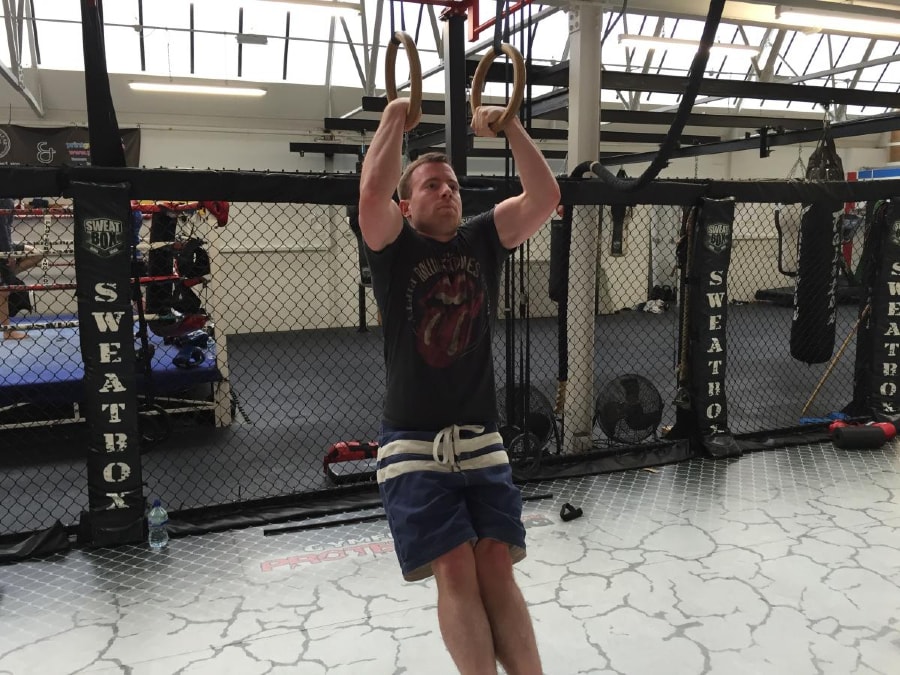Difficulty: Medium/Hard
The muscle-up is one of the most sought after intermediate calisthenic techniques and the foundation for many advanced tricks.
Typically muscle-ups can be done on the bar or on rings, with many people disagreeing on which is the easiest to master. Unlike bar muscle-ups, you can’t achieve a ring muscle-up with sheer strength alone; you’re going to have to work on the strict technique to master this version!
You’ll need a pair of gymnastic rings for this exercise.
Table of Contents
Understanding The False Grip
The most important part of mastering this technique is to first become comfortable with the false grip. The false grip is a gripping style where your wrists are positioned above the ring rather than below it. With the wrist above the ring the pull-up may feel slightly unnatural, but it will make the transition from pull-up to dip much simpler.

First position yourself below the rings and adjust the rings so that they are shoulder width apart, and that when reaching up your wrists are a few centimetres higher than the lowest part of the ring. Hold the ring by placing it between your thumb and forefinger and reaching ‘through’ the ring so that your wrists are high and bent with your fingers pointing downwards. When hanging you want the weight to go over the space between your thumb and forefinger, and then just beneath the outer edge of your palm. At first this should feel slightly odd but will become much more comfortable with practice.

The Technique Needed To Muscle-Up On Gymnastic Rings
Now you’ve got your false grip ready we can dive into the full technique. In short what you want to do is pull yourself up using a false grip, then transition yourself over the rings into a dip, and then push up to straight arms. Unlike bar muscle-ups there is nothing in your way so your movement should be vertical without any kind of swing or kick.
When trying to learn ring muscle-ups most people will often either get it pretty easily or fail miserably, since the technique can be quite hard to grasp. To prevent you from falling into the latter category there’s a few important points to help remember:
- You MUST keep your elbows as close to your body as possible. Beginners will often open their elbows up when transitioning from the pull-up to the dip, however you will lose all your strength the moment you do this. As you progress from pull-up through to the transition you want to keep them tight to your body.
- You need to get your weight comfortably above the rings before you can push up to full arms. When transitioning from the pull-up to the dip, lean forward and bring your elbows backwards in a rotational manner. The best way to do this is to visualise that you are pulling the rings down into your stomach as if you were doing an abdominal crunch.
- Form will certainly beat power when using the rings. Don’t try and jump up or explode upwards; a slow but correct technique is better on this occasion.




Struggling With The Muscle-Up? Try These Muscle-Up Progressions
If you’re still struggling then like most moves you should ensure you’ve got the basics right first.
Try work on the following exercises which are great muscle-up progressions:
- Pull-ups – Ensure you can comfortably complete 6 to 8 reps of pull-ups using the false grip as demonstrated above.
- Practice the transition – Try lowering the rings by a foot or two so when you hang with straight arms your feet are laying rested on the floor. When attempting a muscle-up you can then balance some of your weight on your heels in front of you for an ‘assisted’ muscle-up. This progression is great for those of you who struggle to reach the transition part, as it will allow you to practice that part and get a feel for the movement without being under full strain.
- Dips – If you’re getting your weight over the rings but not quite managing to finish a clean muscle-up, then try focusing on dips using the rings. To get into position lower the rings so they hang at about chest height, and then either jump up or use a box to get up on to the rings. When practising this progression, keep your elbows behind you and ensure you lower yourself as far as you can to really work on the full dip movement.
Working On Muscle-Up Negatives
When you complete a full rep don’t just fall down back to the hanging position. Make sure you lower yourself down in a slow controlled motion, as if you’re doing the whole technique in reverse. You will find lowering yourself slowly and with strict form really helps boost your strength and improve your technique.
Once you feel like you’ve nailed this technique try working on slow Muscle-ups. Rather than trying for a larger number of quick reps, try just one or two reps but as slowly as you possibly can. By doing this you will find you put more effort into perfecting form, which will help make your muscle-ups look extremely impressive!

Founder of www.calisthenics-101.co.uk. Training calisthenics since 2012.
Currently working on: 30 second one-arm handstand, muscle-up 360, straddle planche.
